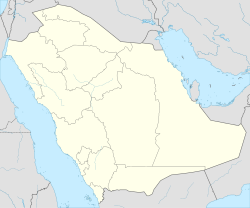Nadjran
| Najran | |
|---|---|

Najran Fort
|
|
| Coordinates: 17°29′30″N 44°7′56″E / 17.49167°N 44.13222°E | |
| Country |
|
| Region | Najran |
| Established | 2000 BC |
| Government | |
| • Mayor | Faris al-Shafaq |
| • Provincial Governor | Jelawi bin Abdulaziz bin Musaed bin Jelawi Al Saud |
| Elevation | 1,293 m (4,242 ft) |
| Population (2010) | |
| • Total | 505,652 |
| Najran Municipality estimate | |
| Area code(s) | (+966) 17 |
| Website | www |
Najran (Arabic: نجران Najrān), is a city in southwestern Saudi Arabia near the border with Yemen. It is the capital of Najran Province. Designated a new town, Najran is one of the fastest-growing cities in the kingdom; its population has risen from 47,500 in 1974 and 90,983 in 1992 to 246,880 in 2004 and 500,000 in 2017. The population mostly originates from the ancient tribe of Yām, Mákram and Hamdan.
Najranis are Muslims, with Shia, Ismaili forming the plurality of the religious adherents. Hanbali, Shafi'i, and Maliki Sunnis form the second largest religious group in the city, while the Zaydi Shia form the smallest religious group.
The Arabic term Najrān has at least two meanings: both the wooden frame on which a door opens and also 'thirsty'. Local tradition also has it that the land derived its name from the first man to settle in the area, Najran ibn Zaydan ibn Saba ibn Yahjub ibn Yarub ibn Qahtan.
Najran was the Yemeni centre of cloth making and originally, the kiswah or the cloth of the Ka'aba was made there (the clothing of the Kaba first started by the Yemeni kings of Saba). There used to be a Jewish community at Najran, renowned for the garments they manufactured. According to Yemenite Jewish tradition, the Jews of Najran traced their origin to the Ten Tribes. Najran was also an important stopping place on the Incense Route.
The history of Najrān can be traced back to 4,000 years ago. It was once occupied by the Romans; in fact it was the first Yemeni city to fall to the Romans on their way to the Yemeni kingdom of Saba'. Najrān's most prosperous trading time was during the 1st and 2nd centuries BC. In ancient times it was known as Al-Ukhdūd.
...
Wikipedia

